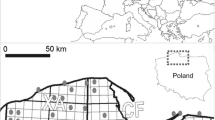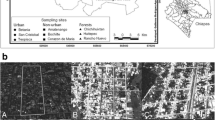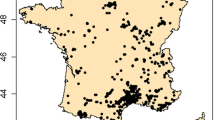Abstract
Different bat species are known to differ in their detectability. Having available presence-absence data from 100 randomly stratified selected 1 km2 squares in the north of the Netherlands, collected during autumn 2009 and spring 2010 following Environmental Impact Assessment protocols, we calculated probabilities of occupancy and detection for ten bat species. Not only did we investigate their presence in general but also of the three main functions a landscape has for a bat: roosting, commuting and foraging. The four most commonly detected species were Pipistrellus pipistrellus, Pipistrellus nathusii, Eptesicus serotinus and Myotis daubentonii. For all species, roosting was the function detected least while the function of foraging was detected most for most species. Probability of detection was highest for P. pipistrellus (0.79), followed by P. nathusii and E. serotinus. They are all relatively loud species, whose presence is hardly missed. For the other seven species, probability of detection was below 0.4 with the lowest value for Plecotus auritus (0.11). The latter species has a very soft echolocation call and is thus often not detected even when present. Our study is the first to use occupancy modelling for European bats. Our results show that the number of visits required to obtain a reliable approximation of occupancy differs widely: from two visits for both Pipistrellus species, to three for E. serotinus and M. daubentonii and even ten for P. auritus. Especially for the latter species, other survey methods may be better employed. This has implications for the design of surveys for Environmental Impact Assessments.



Similar content being viewed by others
References
Adams AM, Jantzen MK, Hamilton RM, Fenton MB (2012) Do you hear what I hear? Implications of detector selection for acoustic monitoring of bats. Methods Ecol Evol 3:992–998. https://doi.org/10.1111/j.2041-210X.2012.00244.x
Andrews H (2018) Chapter 11. Surveilance effort. In: BTHK (ed.). Bat roosts in trees - a guide to identification and assessment for tree-care and ecology professionals. Pelagic Publishing, Exeter
Bailey LL, MacKenzie DI, Nichols JD (2013) Advances and applications of occupancy models. Methods Ecol Evol 5:1269–1279. https://doi.org/10.1111/2041-210X.12100
Barataud M (2015) Acoustic ecology of European bats. Species identification, study of their habitats and foraging behaviour. Biotope, Mèze / Muséum national d’Histoire naturelle, Paris
Barlow KE, Briggs PA, Haysom KA, Hutson AM, Lechiara NL, Racey PA, Walsh AL, Langton SD (2015) Citizen science reveals trends in bat populations: the national bat monitoring programme in Great Britain. Biol Conserv 182:14–26. https://doi.org/10.1016/j.biocon.2014.11.022
Battersby J (compiler) (2010) Guidelines for surveillance and monitoring of European bats. EUROBATS Publication series 5. UNEP/EUROBATS Secretariat, Bonn
Brigham RM, Kalko EKV, Jones G, Parsons S, Limpens HJGA (eds) (2004) Bat echolocation research: tools, techniques and analysis. Bat Conservation International, Austin, Texas
Broekhuizen S, Spoelstra K, Thissen JBM, Canters KJ, Buys JC (2016) Atlas van de Nederlandse zoogdieren. Natuur van Nederland 12. Zoogdiervereniging, Naturalis, Leiden
Dietz C, von Helversen O, Nill D (2007) Handbuch der Fledermäuse Europas und Nordwestafrikas. Biologie, Kennzeichen, Gefährdung. Kosmos, Stuttgart
Duchamp JE, Yates M, Muzika R-M, Swihart RK (2006) Estimating probabilities of detection for bat echolocation calls: an application of the double-observer method. Wildl Soc Bull 34:408–412. https://doi.org/10.2193/0091-7648(2006)34[408:EPODFB]2.0.CO;2
Eklöf J, Jones G (2003) Use of vision in prey detection by brown long-eared bats, Plecotus auritus. Anim Behav 66:949–953. https://doi.org/10.1006/anbe.2003.2272
Fiske I, Chandler RB (2011) unmarked: an R package for fitting hierarchical models of wildlife occurrence and abundance. J Stat Softw 43:1–23
Flaquer C, Torre I, Arrizabalaga A (2007) Comparison of sampling methods for inventory of bat communities. J Mammal 88:526–533. https://doi.org/10.1644/06-MAMM-A-135R1.1
Froideveaux JSP, Zellweger F, Bolmann K, Obrist MK (2014) Optimizing passive acoustic sampling of bats in forests. Ecol Evol 4(24):4690–4700
Goodenough AE, Deans L, Whiteley L, Pickering S (2015) Later is better: optimal timing for walked activity surveys for a European bat guild. Wildl Biol 21:323–328. https://doi.org/10.2981/wlb.00131
Gorresen PM, Miles AC, Todd CM, Bonaccorso FJ, Weller TJ (2008) Assessing bat detectability and occupancy with multiple automated echolocation detectors. J Mammal 89:11–17. https://doi.org/10.1644/07-MAMM-A-022.1
Kaiser ZDE, O’Keefe JM (2015) Factors affecting acoustic detection and site occupancy of Indiana bats near a known maternity colony. J Mammal 96:344–360. https://doi.org/10.1093/jmammal/gyv036
Kerbiriou C, Bas Y, Le Viol I, Lorrilliere R, Mougnot J, Julien JF (2018) Potential of bat pass duration measures for studies of bat activity. Bioacoustics 28:177–192. https://doi.org/10.1080/09524622.2017.1423517
Kyheröinen EM, Aulagnier S, Dekker J, Dubourg-Savage M-J, Ferrer B, Gazaryan S, Georgiakakis P, Hamidovic D, Harbusch C, Haysom K, Jahelková H, Kervyn T, Koch M, Lundy M, Marnell F, Mitchell-Jones A, Pir J, Russo D, Schofield H, Syvertsen PO, Tsoar A (2019) Guidance on the conservation and management of critical feeding areas and commuting routes for bats. EUROBATS Publication Series No. 9. UNEP/EUROBATS Secretariat, Bonn
Limpens H, Hollander H (2001) Herkenning van Nederlandse vleermuissoorten aan hun geluid. Handreiking bij CD. Zoogdiervereniging VZZ, Arnhem
Lintott PR, Fuentes-Montemayor E, Goulson D, Park KJ (2014) Testing the effectiveness of surveying techniques in determining bat community composition within woodland. Wildl Res 40:675–684. https://doi.org/10.1071/WR13153
MacKenzie DI, Nichols JD, Hines JE, Knutson MG, Franklin AB (2003) Estimating site occupancy, colonization, and local extinction when a species is detected imperfectly. Ecology 84:2200–2207. https://doi.org/10.1890/02-3090
Meyer CFJ (2015) Methodological challenges in monitoring bat population- and assemblage-level changes for anthropogenic impact assessment. Mamm Biol:159–169. https://doi.org/10.1016/j.mambio.2014.11.002
Meyer CFJ, Aguiar LMS, Aguirre LF, Baumgarten J, Clarke FM, Cosson J-F, Estrada Villegas S, Fahr J, Faria D, Furey N, Henry M, Hodgkison R, Jenkins RKB, Jung KG, Kingston T, Kunz TH, MacSwiney Gonzalez MC, Moya I, Patterson BP, Pons J-M, Racey PA, Rex K, Sampaio EM, Solari S, Stoner KE, Voigt CC, von Staden D, Weise CD, Kalko EKV (2011) Accounting for detectability improves estimates of species richness in tropical bat surveys. J Appl Ecol 48:777–787. https://doi.org/10.1111/j.1365-2664.2011.01976.x
Murray KL, Fraser E, Davy C, Fleming TH, Fenton MB (2007) Characterization of the echolocation calls of bats from Exuma, Bahamas. Acta Chiropterol 11:415–424. https://doi.org/10.3161/150811009X485639
Neuweiler G (1989) Foraging ecology and audition in echolocating bats. Trends Ecol Evol 4:160–166. https://doi.org/10.1016/0169-5347(89)90120-1
R Core Team (2016) R: a language and environment for statistical computing. R Foundation for Statistical Computing, Vienna. www.R-project.org
Richardson SM, Lintott PR, Hosken DJ, Mathews F (2019) An evidence-based approach to specifying survey effort in ecological assessments of bat activity. Biol Conserv 231:98–102. https://doi.org/10.1016/j.biocon.2018.12.014
Roemer C, Disca T, Coulon A, Bas Y (2017) Bat flight height monitored from wind masts predicts mortality risk at wind farms. Biol Conserv 215:116–122. https://doi.org/10.1016/j.biocon.2017.09.002
Rydell J (1993) Variation in the sonar of an aerial-hawking bat (Eptesicus nilssonii). Ethology 93:275–284. https://doi.org/10.1111/j.1439-0310.1993.tb01209.x
Schaub A, Schnitzler H-U (2007) Echolocation behavior of the bat Vespertilio murinus reveals the border between the habitat types “edge” and “open space.” Behav Ecol Sociobiol 61:513–523. https://doi.org/10.1007/s00265-006-0279-9
Teets KD, Loeb SC, Jachowski DS (2019) Detection probability of bats using active versus passive monitoring. Acta Chiropterol 21:205–213. https://doi.org/10.3161/15081109ACC2019.21.1.017
Tillon L, Barataud M, Giosa S, Aulagnier S (2019) Acoustic detection of radiotracked foraging bats in temperate lowland forests. Mamm Biol 95:155–159. https://doi.org/10.1016/j.mambio.2018.06.008
Tingley MW, Beissinger SR (2009) Detecting range shifts from historical species occurrences: new perspectives on old data. Trends Ecol Evol 24:625–633. https://doi.org/10.1016/j.tree.2009.05.009
Van der Vliet RE, Limpens HJGA, Aragon van den Broeke M, Bouman HB, Heijligers WHC (2017) Modellering voorkomen vleermuizen. Landschap 34:38–48
Vleermuisvakberaad Netwerk Groene Bureaus, Zoogdiervereniging, Gegevensautoriteit Natuur (2009–2010) Het protocol voor vleermuisinventarisaties. Versions 2 April 2009 and 5 March 2010. Available from: www.netwerkgroenebureaus.nl
Voigt CC, Azam C, Dekker J, Ferguson J, Fritze M, Gazaryan S, Hölker F, Jones G, Leader N, Lewanzik D, Limpens HJGA, Mathews F, Rydell J, Schofield H, Spoelstra K, Zagmajster M (2018) Guidelines for consideration of bats in lighting projects. EUROBATS Publication Series No. 8. UNEP/EUROBATS Secretariat, Bonn
Weller TJ (2008) Using occupancy estimation to assess the effectiveness of a regional multiple-species conservation plan: bats in the Pacific Northwest. Biol Conserv 141:2279–2289. https://doi.org/10.1016/j.biocon.2008.06.018
Acknowledgements
We would like to thank all field workers from Tauw and Zoogdiervereniging VZZ for making this paper possible. This study was funded by TenneT TSO bv. Wim Heijligers and Remco Schreuders, formerly from Tauw bv, acted as project leaders for the field research that formed the basis of this study.
Funding
This study was funded by TenneT TSO bv.
Author information
Authors and Affiliations
Contributions
Jasja Dekker and Wiegert Steen performed main analyses. Jasja Dekker, Herman Bouman and Roland van der Vliet wrote the first drafts of the manuscript. All authors read and approved the final manuscript.
Corresponding author
Ethics declarations
Consent to participate
All authors agree to submit this manuscript and all obtained consent from the responsible authorities at the institute/organisation where the work has been carried out.
Consent for publication
All authors agree with the content of this manuscript.
Conflict of interest
The authors declare no competing interests.
Additional information
Publisher's Note
Springer Nature remains neutral with regard to jurisdictional claims in published maps and institutional affiliations.
Rights and permissions
About this article
Cite this article
Dekker, J., Steen, W., Bouman, H.B. et al. Differences in acoustic detectibility of bat species hamper Environmental Impact Assessment studies. Eur J Wildl Res 68, 14 (2022). https://doi.org/10.1007/s10344-022-01562-1
Received:
Revised:
Accepted:
Published:
DOI: https://doi.org/10.1007/s10344-022-01562-1




